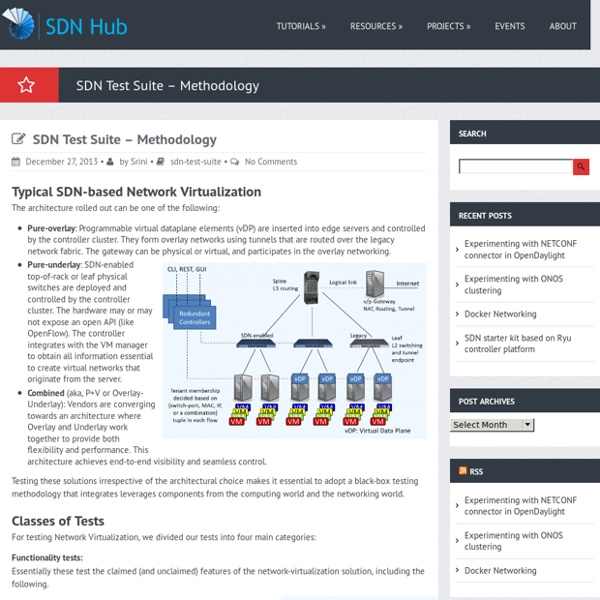Useful mininet setups | SDN Hub
Mininet is a network emulation platform that is very useful to test SDN applications that you build. It can support different types of topologies. Here we showcase three popular configurations that will be helpful for testing. 1. Following command spawns a single switch with 3 hosts attached to it. $ sudo mn --arp --topo single,3 --mac --switch ovsk --controller remote In the above command, there are some important keywords worth paying attention to: –mac: Auto set MAC addresses–arp: Populate static ARP entries of each host in each other–switch: ovsk refers to kernel mode OVS–controller: remote controller can take IP address and port number as options You can now perform ping between hosts h1 and h2 using command h1 ping h2. 2. Following command spawns two switches connected to each other with a link and has one host on each switch. $ sudo mn --topo linear --switch ovsk --controller remote 3. Following command spawns a switch that has 3 servers and 1 client connected to it.
Software Defined Networking - Princeton University | Coursera
About the Course This course introduces software defined networking, an emerging paradigm in computer networking that allows a logically centralized software program to control the behavior of an entire network. Separating a network's control logic from the underlying physical routers and switches that forward traffic allows network operators to write high-level control programs that specify the behavior of an entire network, in contrast to conventional networks, whereby network operators must codify functionality in terms of low-level device configuration. Logically centralized network control makes it possible for operators to specify more complex tasks that involve integrating many disjoint network functions (e.g., security, resource control, prioritization) into a single control framework, allowing network operators to create more sophisticated policies, and making network configurations easier to configure, manage, troubleshoot, and debug. Course Syllabus Module 3: Control Plane
Software Defined Networking course GA Tech
About the Course This course introduces software defined networking, an emerging paradigm in computer networking that allows a logically centralized software program to control the behavior of an entire network. Separating a network's control logic from the underlying physical routers and switches that forward traffic allows network operators to write high-level control programs that specify the behavior of an entire network, in contrast to conventional networks, whereby network operators must codify functionality in terms of low-level device configuration. Logically centralized network control makes it possible for operators to specify more complex tasks that involve integrating many disjoint network functions (e.g., security, resource control, prioritization) into a single control framework, allowing network operators to create more sophisticated policies, and making network configurations easier to configure, manage, troubleshoot, and debug. Course Syllabus Module 3: Control Plane Prof.
What is software-defined networking (SDN)? - Definition from WhatIs.com
Software-defined networking (SDN) is an umbrella term encompassing several kinds of network technology aimed at making the network as agile and flexible as the virtualized server and storage infrastructure of the modern data center. The goal of SDN is to allow network engineers and administrators to respond quickly to changing business requirements. In a software-defined network, a network administrator can shape traffic from a centralized control console without having to touch individual switches, and can deliver services to wherever they are needed in the network, without regard to what specific devices a server or other hardware components are connected to. The key technologies for SDN implementation are functional separation, network virtualization and automation through programmability. By submitting your personal information, you agree that TechTarget and its partners may contact you regarding relevant content, products and special offers.
Spanning Tree and OpenFlow
Questions I often get asked include: Can you run Spanning Tree and OpenFlow together?What happens when Spanning Tree blocks a port? What will OpenFlow do? Firstly, it is possible to run an OpenFlow network connected to the HP VAN SDN Controller with Spanning Tree turned off. In this blog entry I will show you a simple network with a look and demonstrate what happens with Spanning Tree turned off as well as on using HP Comware switches. VLAN 1 = Management VLAN (Used for communication with the Controller. In this topology I am using two 5900AF-48G-4XG-2QSFP+ switches with the following details: [5900-1]dis version HP Comware Software, Version 7.1.045, Release 2307 Copyright (c) 2010-2013 Hewlett-Packard Development Company, L.P. [5900-2]dis version HP Comware Software, Version 7.1.045, Release 2307 Copyright (c) 2010-2013 Hewlett-Packard Development Company, L.P. In the output below, you can see that Spanning Tree is disabled on VLAN 10: VLAN 192 is the link to the HP VAN SDN Controller:
Software-Defined Networking (SDN) Definition - Open Networking Foundation
What is SDN? The physical separation of the network control plane from the forwarding plane, and where a control plane controls several devices. Software-Defined Networking (SDN) is an emerging architecture that is dynamic, manageable, cost-effective, and adaptable, making it ideal for the high-bandwidth, dynamic nature of today's applications. This architecture decouples the network control and forwarding functions enabling the network control to become directly programmable and the underlying infrastructure to be abstracted for applications and network services. The OpenFlow® protocol is a foundational element for building SDN solutions. The SDN architecture is: Computing Trends are Driving Network Change SDN addresses the fact that the static architecture of conventional networks is ill-suited to the dynamic computing and storage needs of today’s data centers, campuses, and carrier environments. Open Networking Foundation: Dedicated to SDN Become an ONF Member →



